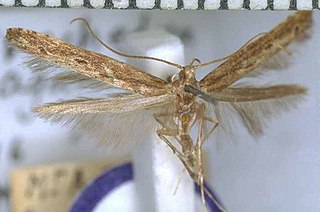
Batrachedra agaura is a species of moth in the family Batrachedridae. It is endemic to New Zealand. This species is distributed throughout the country. The species inhabits native forest especially beech and kanuka forest or manuka scrubland. The larvae of this species is associated with sooty mold and with sooty beech scale. It has been hypothesised that the larvae feed on sooty beech scale. However they may also feed on the sooty mold itself. The adult female is lighter in appearance than the male and the species shows considerable variation in patterns on forewing. Adults are on the wing from October to February. They are nocturnal and occasionally attracted to light.
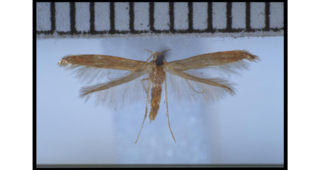
Batrachedra litterata is a species of moth in the family Batrachedridae. It is endemic to New Zealand and has been collected in the North and South Islands. This species has been reared on the fern species Blechnum chambersii. Adults are on the wing in November and December.
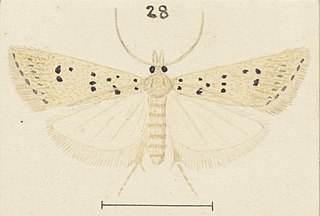
Heterocrossa maculosa is a species of moth in the family Carposinidae. It is endemic to New Zealand. It is classified as "Data Deficient" by the Department of Conservation.

Glyphipterix acronoma is a species of sedge moth in the genus Glyphipterix. It is endemic to New Zealand and is found in the North and South Islands. It's preferred habitat is open fields on mountain sides and adults are on the wing in December and January.
Phaeosaces lindsayae is a species of moth in the family Depressariidae. It is endemic to New Zealand. It is classified as "Data Deficient" by the Department of Conservation.
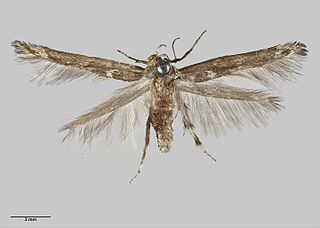
Stathmopoda albimaculata is a species of moth in the Stathmopodidae family. It is endemic to New Zealand and is located in the lower half of the South Island. This species favours habitat that includes the various Olearia species that host its larvae. It has also been found to inhabit lowland podocarp native forest. The larvae feed on species in the genus Olearia. Adults are on the wing between the months of October and February. S. albimaculata is classified as Nationally Endangered by the Department of Conservation.
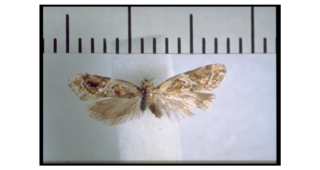
Trachypepla roseata is a species of moth in the family Oecophoridae. This species is endemic to New Zealand and is found in the Nelson and Tasman regions of the South Island. It frequents forest habitat and is on the wing in January. It is classified as "Data Deficient" by the Department of Conservation.

Archyala opulenta is a species of moth of the family Tineidae. This species is endemic to New Zealand has been found in the upper Maitai Valley in Nelson as well as in Northland. The larvae of this species are associated with endemic bat species as they feed on the guano of Mystacinidae. The adult moths are on the wing in November. It is classified as "Data Deficient" under the New Zealand Threat Classification System by the Department of Conservation.
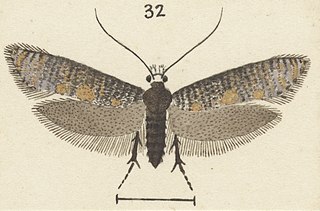
Archyala lindsayi is a species of moth in the family Tineidae. This species is endemic to New Zealand. It is classified as "At Risk, Naturally Uncommon" by the Department of Conservation.

Orocrambus ornatus is a moth in the family Crambidae. This species is endemic to New Zealand. It is classified as critically endangered by the Department of Conservation.

Elachista sagittifera is a species of moth in the family Elachistidae. It was described by Alfred Philpott in 1927. It is endemic to New Zealand and is known from Arthur's Pass. It is similar in appearance to Elachista thallophora. Adults are on the wing in February.

Anisoplaca fraxinea is a species of moth of the family Gelechiidae. It was described by Alfred Philpott in 1928 and is endemic to New Zealand. It has been observed in the South Island and adults are on the wing in February and March.

Kiwaia pumila is a moth in the family Gelechiidae. It is endemic to New Zealand. It is classified as Nationally Vulnerable by the Department of Conservation.

Pseudocoremia fluminea is a species of moth in the family Geometridae. It is endemic to New Zealand. It is classified as Not Threatened by the Department of Conservation.

Cnephasia paterna is a species of moth in the family Tortricidae. It is endemic to New Zealand. This species is classified as Nationally Endangered by the Department of Conservation.

Archyala culta is a species of moth in the family Tineidae. This species is endemic to New Zealand. It is classified as "Data Deficient" by the Department of Conservation. This species has only been collected at Opoho and is only known from its type specimen.
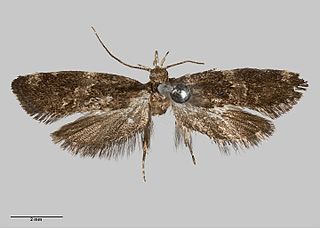
Trachypepla nimbosa is a species of moth in the family Oecophoridae. It is endemic to New Zealand. This species has been collected in Auckland as well as one specimen in the West Coast. Adults are on the wing in January however the West Coast specimen was collected in November. This species is classified as "Data Deficient" by the Department of Conservation.

Tingena enodis is a species of moth in the family Oecophoridae. It is endemic to New Zealand and has been collected in and around Nelson. This species can only be reliably distinguished from its close relatives through the different shape of its male genitalia. As at 1939 a female specimen had yet to be assigned to this species.

Tingena grata is a species of moth in the family Oecophoridae. It is endemic to New Zealand and has been found in the South Island. The adults of this species are on the wing from November to January.
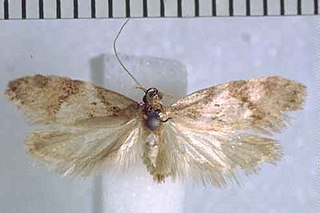
Trachypepla angularis is a species of moth in the family Oecophoridae. It is endemic to New Zealand and has been collected at Lake Rotoroa in the Nelson Lakes National Park in January. This species inhabits mixed native forest.



















